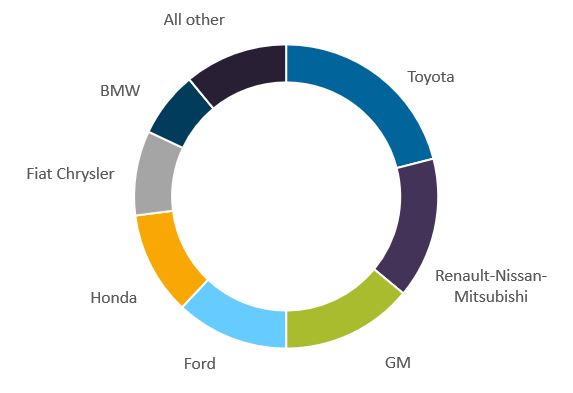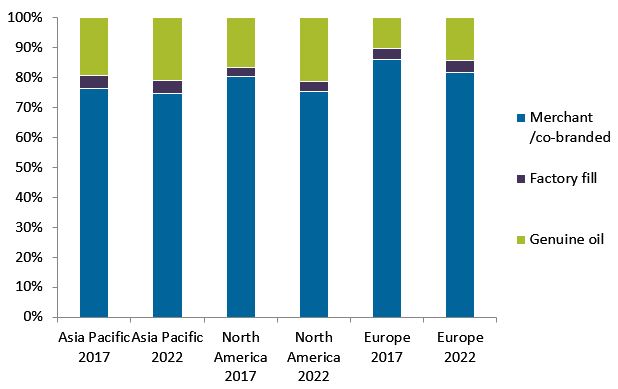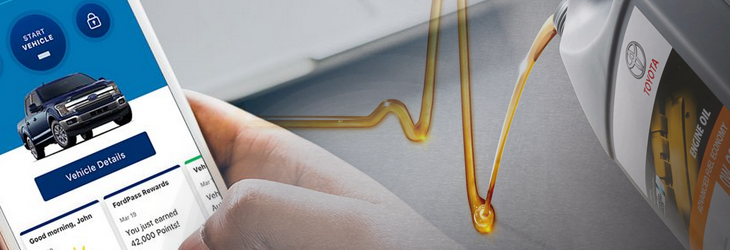 Despite the fact that OEM genuine oils account for just 15% of the 7.3 million tonne global PCMO market, Kline’s Project Manager, David Tsui, outlines why, in a highly competitive market, this segment will experience strong growth, which will have repercussions for branded aftermarket lubricant suppliers.
Despite the fact that OEM genuine oils account for just 15% of the 7.3 million tonne global PCMO market, Kline’s Project Manager, David Tsui, outlines why, in a highly competitive market, this segment will experience strong growth, which will have repercussions for branded aftermarket lubricant suppliers.
With margins on new car sales as low as 7%-10%, OEMs are looking to generate additional revenue via new products and services to help improve profits. Currently, OEM genuine oil represents about 10%-20% of passenger car motor oil (PCMO) consumption, and just seven OEMs account for ~ 89% of the global market.
Estimated Global Genuine Oil Consumption by OEM, 2017

However, this picture could be set to change as more OEMs recognize the value that genuine oils can add to their product offerings. An increase in OEM genuine oils would, however, threaten established branded aftermarket lubricant suppliers.
There are two key factors beyond the desire for increased margins that are driving OEMs to grow a profitable aftermarket business based on their own genuine oils. First, doing so is a way to improve customer loyalty; second, doing so can minimize vehicle warranty claims.
Driving customer loyalty
In an era when competition between OEMs for new vehicle sales is extremely high, boosting customer loyalty and creating opportunities for rapport is essential. Regularly bringing owners into dealerships, offering an exceptional customer experience, and using the time to introduce new products and services are some of the ways OEMs can increase the likelihood of retaining future vehicle purchase business.
The fixed operations side of business at dealerships, which includes vehicle servicing, currently accounts for about half of the revenue generated and is one area gaining significant attention. Most OEMs incentivize the dealerships to use genuine parts and oils, particularly because customers view these products as an extension of the OEM brand and, in the high-end bracket, expect premium, long-drain lubes to be supplied.
In the more mature markets, there is a growing trend for customers to go back to dealerships rather than using “do it for me” (DIFM) style operations for servicing and oil changes. This is generally because today’s vehicles are more complex, requiring trained technicians; also, as the market becomes more competitive, dealers are offering promotions to attract customers to use their services.
Ford ranks high in customer loyalty
The Kline survey identifies Ford as one of the top OEMs for customer loyalty and dealer compliance. And, in line with market trends, the OEM has announced plans to double its corporate expenditure on customer service, introducing new products and services in support of its dealers.
Ford Omnicraft, for example, was the first new brand from Ford’s Customer Service Division in more than 40 years, which will eventually offer over 8,000 replacement parts that can be fitted to just about any vehicle. This enables Ford dealers to service all makes of non-Ford vehicles and to become a one-stop provider of parts to used vehicle outlets, fleet managers and independent garages. The suite of more than 2,000 replacement parts, which can be fitted to just about any vehicle, enables Ford dealers to service all makes of non-Ford vehicles and become a one-stop provider of parts to used vehicle outlets, fleet managers, and independent garages. Another introduction from Ford is the FordPass Rewards program, which enables consumers to earn reward points on service spending at Ford dealers. The OEM is also piloting mobile servicing in the United States, bringing vehicle maintenance and light servicing to just about anywhere a customer wants. In addition, Ford is working with its dealers to test new global retail formats based on the changing ways people shop today.
All these new introductions are designed to not only drive customers back into dealerships but also make the Ford ownership experience easier and worry-free to build customer ranks and revenues over time.
Reducing warranty claims
Carrying out vehicle servicing at a dealership using genuine oil is also regarded by OEMs as one way to help reduce warranty claims. This is, in part, because they can use highly trained technicians who fully understand increasingly complex vehicle technologies. But it is also because the genuine OEM oil used will have been carefully formulated to protect their specific engines.
This is not generally the case for Merchant PCMO products, which are typically mass-market engine oils designed to meet a wide range of industry specifications. However, these industry specifications can take a long period of time to update and may not fully satisfy all stakeholder requirements. In North America, for example, when the first allowable use date of May 2020 arrives for ILSAC GF-6, more than eight-and-a-half years will have elapsed since the needs statement was issued.
The same is not the case for genuine oils, since OEMs have the ability to more quickly respond to reported issues by developing specific tests to ensure engine protection is maintained. This has been observed recently when low-speed pre-ignition (LSPI) issues, which can lead to severe engine knock, were observed in the field. In response, some OEMs have developed their own tests and launched anti-LSPI engine oils to protect their specific engines.
Future disruptors
Looking ahead, two of the biggest disruptors are likely to be the establishment of quick lubes facilities at dealerships and the adoption of ride sharing. Quick lubes built into new car dealerships have been growing nationally with Ford’s Quick Lane at nearly 5,000 dealerships and other OEMs, such as Nissan, Toyota, Chrysler, and GM, all racing to catch up, with many already at more than 1,000 dedicated quick lube centers.
In terms of ride sharing, some OEMs are buying stakes in this market and creating mobility service companies that enable customers to order a car via their mobile phone. As ride sharing grows, OEMs are working to position themselves as the provider of cars on which these services rely to operate, moving car ownership from the independent ride sharing company to the OEM. This enables OEMs to control where the vehicles will return for servicing, which means lubricant volumes could be expected to move away from DIFM channels to OEMs and dealerships.
If these emerging trends take off as expected, there could be a significant positive impact on the genuine OEM oil market.
Genuine oil outlook
Regardless of the uptake of dealership quick lubes and ride sharing, the OEM genuine oil market is forecast to grow faster than PCMO across the regions.
Regional PCMO market by product type 2017 and 2022

In developing markets, growth will be driven by customer loyalty and continued vehicle market growth. In established markets, although declining loyalty will likely dampen sales, particularly in markets where OEMs cannot require customers to return to dealerships to maintain vehicle warranty, growth will come from increased vehicle sales. In the more mature markets, where vehicles tend to be more expensive and complex, growth in genuine oil use will come as consumers return to dealerships that have trained technicians who they perceive will take better care of their car.
New report on OEM genuine oils
Kline Group’s report, OEM Genuine Oil Brands and Programs in the Consumer Automotive Segment: Market: Analysis and Opportunities, provides a detailed and independent appraisal of the market and examines growth drivers and expansion potential. The report profiles eight country markets and looks at 17 OEMs, including some of the biggest automakers, such as VW, Toyota and GM, and smaller OEMs—for example, Mahindra—which have recently jumped into the genuine oil market.
In addition, readers will gain an understanding of penetration levels by OEMs and the competitive threat posed to branded aftermarket lubricant suppliers.
References
Ford loyalty
https://media.ford.com/content/fordmedia/fna/us/en/news/2019/05/02/ford-sharpens-focus-on-customer-experience.html

